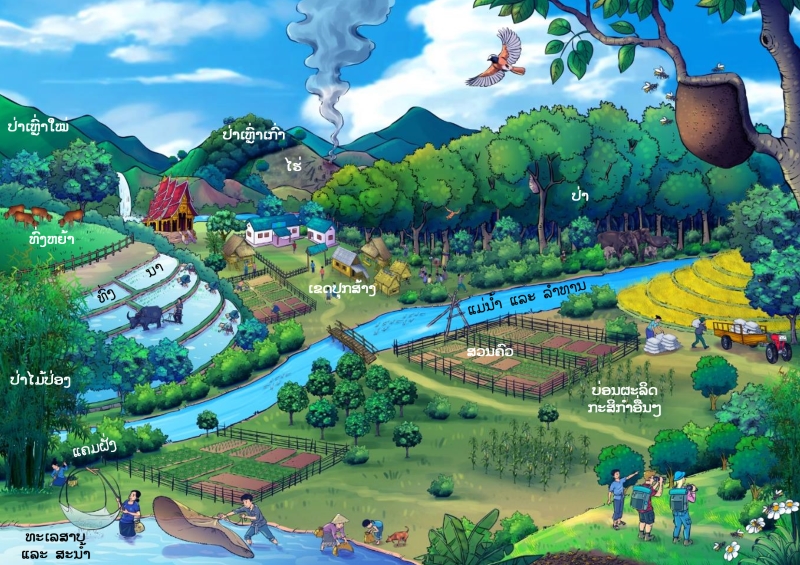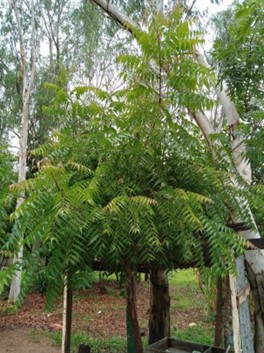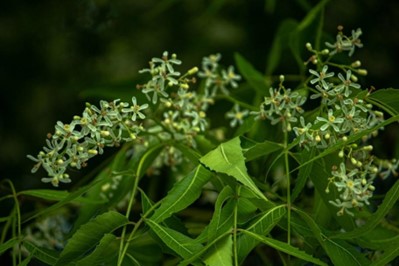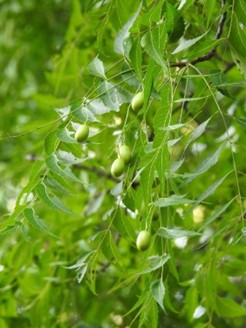ເລກລຳດັບທີ: 39
ລະດັບການຮວບຮວມຂໍ້ມູນ: ເກີອບສົມບູນ
ປັບປູງຄັ້ງລ່າສຸດ: 2025-03-03
ຜັກກະເດົາ
Indian lilac
Azadirachta indica A.Juss.
ພືດ
ໄມ້ຢືນຕົ້ນ
ຕົ້ນໄມ້ ແລະ ປາມ
×
ຊື່ທ້ອງຖີ່ນ:
ຂົມກະເດົາ ( Neem, Neem Tree, nimtree)
ຊື່ພ້ອງ
:
Antelaea azadirachta (L.) Adelb.
Antelaea canescens Cels
Antelaea canescens Cels ex Heynh.
Antelaea javanica Gaertn.
Azadirachta indica subsp. vartakii Kothari, Londhe & N.P.Singh
Azadirachta indica var. minor Valeton
Azadirachta indica var. siamensis Valeton
Azedarach deleteria Medik.
Azedarach fraxinifolia Moench
Melia azadirachta L.
Melia fraxinifolia Salisb.
Melia hasskarlii K.Koch
Melia indica (A.Juss.) Brandis
Melia japonica Hassk.
Melia parviflora Moon
Melia pinnata Stokes
Antelaea canescens Cels
Antelaea canescens Cels ex Heynh.
Antelaea javanica Gaertn.
Azadirachta indica subsp. vartakii Kothari, Londhe & N.P.Singh
Azadirachta indica var. minor Valeton
Azadirachta indica var. siamensis Valeton
Azedarach deleteria Medik.
Azedarach fraxinifolia Moench
Melia azadirachta L.
Melia fraxinifolia Salisb.
Melia hasskarlii K.Koch
Melia indica (A.Juss.) Brandis
Melia japonica Hassk.
Melia parviflora Moon
Melia pinnata Stokes
ຊື່ສະກຸນ:
Meliaceae
ຊະນິດໃກ້ຄຽງ:
ບັນຍາຍລັກສະນະທາງພືດສາດ:
ຕົ້ນກະເດົາ ເປັນຕົ້ນໄມ້ຂະໜາດນ້ອຍເລັກນ້ອຍ ຫາຂະໜາດກາງ ໂດຍທົ່ວໄປຈະສູງລະຫວ່າງ 15 ຫາ 30 ມ., ເປືອກໜາປານກາງ, ຜິວດ້ານນອກເປັນສີເທົາເຂັ້ມ ແລະ ດ້ານໃນເປັນສີແດງ, ເມື່ອຕົ້ນໄມ້ມີອາຍຸຫຼາຍຂື້ນເປອກຈະມີຮ່ອຍແຕກເປັນຮ່ອງເລິກ.
ໃບປະສົມ, ອອກຮຽງສະຫຼັບ, ມັກເຈັບເປັນກຸ່ມຢູ່ບໍລິເວນປາຍໃບ ແລະ ມີສີຂຽວອ່ອນ, ຍາວ 20 ຫາ 40 ຊມ., ກ້ານໃບລວມຍາວ 2 ຫາ 7 ຊມ. ມີໃບຍ່ອຍຂະໜາດນ້ອຍ 8 ຫາ 19 ໃບ, ຈັບຮຽງກົງກັນຂ້າມ, ໂດຍໃບຍ່ອຍສອງສາມໃບທຳອິດຈະຈັບຮຽງສະຫຼັບກັນ, ຍາວປະມານ 3,5 ຫາ 10 ຊມ. ແລະ ກວ້າງ 1,2 ຫາ 4 ຊມ.
ຕົ້ນກະເດົາອອກດອກເປັນຊໍ່ ເອີ້ນວ່າຊໍ່ດອກ ຊໍ່ຮູບກະຈະ, ຍາວຮອດ 30 ຊມ., ອອກຕາມງ່າມໃບ ແລະ ປາຍກິ່ງ. ດອກຍ່ອຍມີກີບດອກ 5 ກີບ, ສີຂາວ ຫຼື ສີເຫຼືອງອ່ອນ, ມີກິນຫອມອ່ອນ.
ໝາກຂອງຜັກກະເດົາມີເນື້ອຫຸ້ມແກ່ນ 1 ຫາ 2 ແກ່ນ, ໝາກຮູບຮີ, ໂດຍຍາວ 1 ຫາ 2 ຊມ. ໝາກດິບມີສີຂຽວ ແຕ່ເມື່ອສຸກແລ້ວຈະປ່ຽນເປັນສີຂຽວອົມເຫຼືອງ.
ແຫຼ່ງທີ່ມາ: [4]
ໃບປະສົມ, ອອກຮຽງສະຫຼັບ, ມັກເຈັບເປັນກຸ່ມຢູ່ບໍລິເວນປາຍໃບ ແລະ ມີສີຂຽວອ່ອນ, ຍາວ 20 ຫາ 40 ຊມ., ກ້ານໃບລວມຍາວ 2 ຫາ 7 ຊມ. ມີໃບຍ່ອຍຂະໜາດນ້ອຍ 8 ຫາ 19 ໃບ, ຈັບຮຽງກົງກັນຂ້າມ, ໂດຍໃບຍ່ອຍສອງສາມໃບທຳອິດຈະຈັບຮຽງສະຫຼັບກັນ, ຍາວປະມານ 3,5 ຫາ 10 ຊມ. ແລະ ກວ້າງ 1,2 ຫາ 4 ຊມ.
ຕົ້ນກະເດົາອອກດອກເປັນຊໍ່ ເອີ້ນວ່າຊໍ່ດອກ ຊໍ່ຮູບກະຈະ, ຍາວຮອດ 30 ຊມ., ອອກຕາມງ່າມໃບ ແລະ ປາຍກິ່ງ. ດອກຍ່ອຍມີກີບດອກ 5 ກີບ, ສີຂາວ ຫຼື ສີເຫຼືອງອ່ອນ, ມີກິນຫອມອ່ອນ.
ໝາກຂອງຜັກກະເດົາມີເນື້ອຫຸ້ມແກ່ນ 1 ຫາ 2 ແກ່ນ, ໝາກຮູບຮີ, ໂດຍຍາວ 1 ຫາ 2 ຊມ. ໝາກດິບມີສີຂຽວ ແຕ່ເມື່ອສຸກແລ້ວຈະປ່ຽນເປັນສີຂຽວອົມເຫຼືອງ.
ແຫຼ່ງທີ່ມາ: [4]
ນິເວດວິທະຍາ
ເຂດກະຈາຍພັນທົ່ວໂລກ:
Native to This species is native to Myanmar, northern India, Bangladesh, Bhutan, Cambodia and Lao PDR [6]
ຊະນິດພັນພື້ນໃນປະເທດມຽນມາ, ອິນເດຍຕອນເໜືອ, ບັງຄາລາເທດ, ບູຖານ, ກຳປູເຈຍ, ແລະ ລາວ. [6]
Global distribution between 2002 to 2024. Source: [5]
ການກະຈາຍພັນທົ່ວໂລກລະຫວ່າງປີ 2002 ຫາ 2024. ແຫຼ່ງທີ່ມາ: [2]
ຊະນິດພັນພື້ນໃນປະເທດມຽນມາ, ອິນເດຍຕອນເໜືອ, ບັງຄາລາເທດ, ບູຖານ, ກຳປູເຈຍ, ແລະ ລາວ. [6]
Global distribution between 2002 to 2024. Source: [5]
ການກະຈາຍພັນທົ່ວໂລກລະຫວ່າງປີ 2002 ຫາ 2024. ແຫຼ່ງທີ່ມາ: [2]
ເຂດກະຈາຍພັນໃນລາວ
:
ທົ່ງພຽງວຽງຈັນ
ເຂດສາຍພູຫຼວງພາກເໜືອ
ເຂດສາຍພູຫຼວງຕອນລຸ່ມ
ເຂດລຽບແມ່ນ້ຳຂອງພາກໃຕ້
ລຽບແມ່ນ້ຳຂອງພາກເໜືອ
ເຂດສາຍພູຫຼວງພາກເໜືອ
ເຂດສາຍພູຫຼວງຕອນລຸ່ມ
ເຂດລຽບແມ່ນ້ຳຂອງພາກໃຕ້
ລຽບແມ່ນ້ຳຂອງພາກເໜືອ

ເຂດກະຈາຍພັນຕາມພູມສັນຖານ
:
ປ່າດົງດິບ
ປ່າປະສົມປ່ຽນໃບ
ປ່າໂຄກ
ປ່າປະສົມປ່ຽນໃບ
ປ່າໂຄກ

ສະເພາະຖິ່ນໃນລາວ:
ພື້ນເມືອງ
ຮຸກຮານ
:
ບໍ່ຮຸກຮານ
ສະຖານະພາບການອະນູຮັກ IUCN
:
ມີຄວາມສ່ຽງໜ້ອຍສຸດ
ສະຖານະພາບການອະນຸຮັກແຫ່ງຊາດລາວ
:
ບໍ່ຖືກລະບຸໃນບັນຊີປະເພດໃດ
ການນຳໃຊ້
ປະເພດການນຳໃຊ້:
ກາວ ແລະ ສານຫຼໍ່ລື່ນ
ພະລັງງານ ແລະ ແສງສະຫວ່າງ
ກິດຈະກຳການກະເສດ
ສິ່ງປູກສ້າງ
ອຸປະກອນ ແລະ ເຄື່ອງມື
ອາຫານ
ພືດເປັນຢາ
ພະລັງງານ ແລະ ແສງສະຫວ່າງ
ກິດຈະກຳການກະເສດ
ສິ່ງປູກສ້າງ
ອຸປະກອນ ແລະ ເຄື່ອງມື
ອາຫານ
ພືດເປັນຢາ
ບັນຍາຍການນຳໃຊ້:
ອາຫານ: ດອກຂົມກະເດົາສາມດຮັບະທານໄດ້ ໂດຍເກັບມາຮັບປະທານເປັນຜັກ. ໃບ ແລະ ແກ່ນກະເດົາເປັນອາຫານສັດ.
ເຄື່ອງມື ແະ ອຸປະກອນ: ໃຊ້ເປັນດ້າມເຄື່ອງມືອຸປະກອນ, ປະຕູ ແລະ ເຟີນີເຈີ ເຖິ່ງແມ່ນວ່າຈະບໍ່ຄ່ອຍໃຊ້ໃນດ້ານການກໍ່ສ້າງກໍ່ຕາມ, ຄວາມທົນທານ ແລະ ການໃຊ້ງານ ເຮັດໃຫ້ໄມ້ຕົ້ນກະເດົາເປັນຕົວເລືອກໃນງານຊ່າງໄມ້ຕ່າງໆ.
ພະລັງງານ ແລະ ແສງສະຫວ່າງ: ໄມ້ກະເດົາເປັນແຫຼ່ງເຊື້ອເພີງທີ່ສຳຄັນ ໂດຍຈະໃຊ້ເປັນຟືນສຳຫຼັບແຕ່ງກິນ ແລະ ໃຫ້ຄວາມຮ້ອນ, ໄມ້ຕົ້ນກະເດົາເຜົາໄໝ້ໄດ້ດີ.
ແຫຼ່ງທີ່ມາ: [6]
ເຄື່ອງມື ແະ ອຸປະກອນ: ໃຊ້ເປັນດ້າມເຄື່ອງມືອຸປະກອນ, ປະຕູ ແລະ ເຟີນີເຈີ ເຖິ່ງແມ່ນວ່າຈະບໍ່ຄ່ອຍໃຊ້ໃນດ້ານການກໍ່ສ້າງກໍ່ຕາມ, ຄວາມທົນທານ ແລະ ການໃຊ້ງານ ເຮັດໃຫ້ໄມ້ຕົ້ນກະເດົາເປັນຕົວເລືອກໃນງານຊ່າງໄມ້ຕ່າງໆ.
ພະລັງງານ ແລະ ແສງສະຫວ່າງ: ໄມ້ກະເດົາເປັນແຫຼ່ງເຊື້ອເພີງທີ່ສຳຄັນ ໂດຍຈະໃຊ້ເປັນຟືນສຳຫຼັບແຕ່ງກິນ ແລະ ໃຫ້ຄວາມຮ້ອນ, ໄມ້ຕົ້ນກະເດົາເຜົາໄໝ້ໄດ້ດີ.
ແຫຼ່ງທີ່ມາ: [6]
ການປູກ ການລ້ຽງ:
ຊະນິດທຳມະຊາດ
ລະດູການເກັບກູ້:
ມັງກອນ
ກຸມພາ
ມີນາ
ເມສາ
ພຶກສະພາ
ມິຖຸນາ
ກໍລະກົດ
ສິງຫາ
ກັນຍາ
ຕຸລາ
ພະຈິກ
ທັນວາ
ກຸມພາ
ມີນາ
ເມສາ
ພຶກສະພາ
ມິຖຸນາ
ກໍລະກົດ
ສິງຫາ
ກັນຍາ
ຕຸລາ
ພະຈິກ
ທັນວາ
ການຕະຫຼາດ ແລະ ຕ່ອງໂສ້ມູນຄ່າ:
N/A
ການຄຸ້ມຄອງຈັດການ
N/A
ໂພຊະນາການ
ຄຸນຄ່າທາງໂພຊະນາການ:
ບັນຍາຍຄຸນຄ່າທາງໂພຊະນາການ:
N/A
| ສານອາຫານ | /100g | ໝາຍເຫດ |
|---|---|---|
| ໂປຣຕີນ | N/A | N/A |
| ຄາໂບໄຮເດຣດ | N/A | N/A |
| ໄຂມັນ | N/A | N/A |
| ວິຕາມິນ | N/A | N/A |
| ແຮ່ທາດ | N/A | N/A |
| ເສັ້ນໄຍ | N/A | N/A |
ອ້າງອິງ
ເຄດິດຮູບພາບ:
Grown neem tree. [1] iNaturalist [Online]. Uploaded on 1 July 2020 by: O. Martinez. Available: https://www.inaturalist.org/observations/53194781. [Accessed: 26 August 2024]
Inflorescence and Flowers of the neem tree. [2] iNaturalist [Online]. Uploaded on 5 May 2022 by: ijeez. Available: https://www.inaturalist.org/observations/115551363. [Accessed: 26 August 2024]
Fruit of the neem tree. [3] iNaturalist [Online]. Uploaded on 23 August 2023 by: S. Udayraj. Available: https://www.inaturalist.org/observations/179780424. [Accessed: 26 August 2024]
Inflorescence and Flowers of the neem tree. [2] iNaturalist [Online]. Uploaded on 5 May 2022 by: ijeez. Available: https://www.inaturalist.org/observations/115551363. [Accessed: 26 August 2024]
Fruit of the neem tree. [3] iNaturalist [Online]. Uploaded on 23 August 2023 by: S. Udayraj. Available: https://www.inaturalist.org/observations/179780424. [Accessed: 26 August 2024]
ອ້າງອິງ:
[4] World Agroforestry, “Azadirachta indica,” [Online]. Available: https://apps.worldagroforestry.org/treedb/AFTPDFS/Azadirachta_indica.PDF. [Accessed: 26 August 2024]
[5] Global Biodiversity Information Facility (GBIF), “Picea abies,” [Online]. Available: https://www.gbif.org/species/3190474/treatments. [Accessed: 26 August 2024]
[6] International Union for Conservation of Nature (IUCN) Red List of Threatened Species, “Acanthophoenix crinita,” [Online]. Available: https://www.iucnredlist.org/species/61793521/61793525. [Accessed: 26 August 2024]
[7] World Agroforestry, “Azadirachta indica,” [Online]. Available: https://apps.worldagroforestry.org/treedb/AFTPDFS/Azadirachta_indica.PDF. [Accessed: 26 August 2024]
[5] Global Biodiversity Information Facility (GBIF), “Picea abies,” [Online]. Available: https://www.gbif.org/species/3190474/treatments. [Accessed: 26 August 2024]
[6] International Union for Conservation of Nature (IUCN) Red List of Threatened Species, “Acanthophoenix crinita,” [Online]. Available: https://www.iucnredlist.org/species/61793521/61793525. [Accessed: 26 August 2024]
[7] World Agroforestry, “Azadirachta indica,” [Online]. Available: https://apps.worldagroforestry.org/treedb/AFTPDFS/Azadirachta_indica.PDF. [Accessed: 26 August 2024]
ຜູ້ສ້າງ Factsheet:
ຜູ້ກວດສອບ Factsheet:
,


